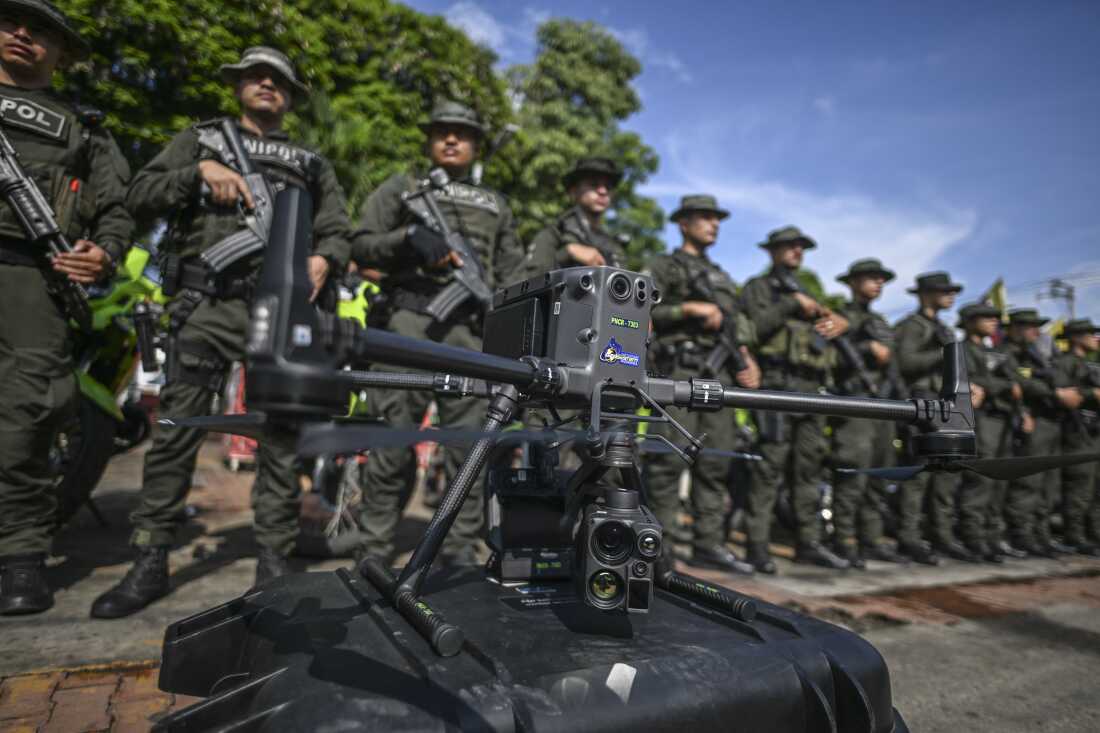Cops stand in formation behind a drone that will probably be used to extend the safety in Jamundi, Valle del Cauca province, Colombia, on June 13, 2024.
JOAQUIN SARMIENTO/AFP through Getty Photographs
disguise caption
toggle caption
JOAQUIN SARMIENTO/AFP through Getty Photographs
BOGOTÁ, Colombia – Inside a cavernous hangar subsequent to Bogotá’s worldwide airport, navy officers are testing a brand new weapon: a Colombian-made drone that may carry as much as 18 kilos of explosives.
“It’s a tactical drone that’s easy for troops to carry but one that also has a lot of firepower,” says Colombian Air Power Col. Andrés Talavera, who’s overseeing the take a look at flight.
The drone is the newest salvo within the authorities’s battle towards guerrillas and drug-traffickers. However though unmanned aerial autos have change into important weapons in conflicts from Ukraine to the Center East, Colombia is a late comer to drone warfare.
Colombia’s battle has been occurring because the Nineteen Sixties however the violence had been lowering in recent times. That was attributable to a 2016 peace treaty that disarmed the nation’s largest guerrilla military in addition to ceasefires with smaller prison teams.
However over the previous 12 months, these ceasefires have collapsed.
Now, says Military Gen. Juan Carlos Correa, the criminals are utilizing drones to observe their drug crops and cocaine laboratories, goal rival smugglers, and ambush police and military troops. Over the previous two years, these teams have efficiently attacked safety forces about 200 occasions with explosive-laden drones.
“In one single day they launched 17 attacks,” Correa informed NPR.
The expertise is cheap and extensively obtainable. The drug traffickers purchase industrial drones on-line for a thousand {dollars} or so, then connect selfmade explosives to them.
Air Power Gen. Andrés Guzmán, who heads CIAC, the state-run firm producing Colombia’s navy drones, says that as a result of the brand new expertise is so low-cost, it has supplied an enormous increase for prison teams.
“The conflict will always be a David vs. Goliath situation but a drone can be the perfect solution for these groups when they are confronting the military, which has a lot more technology,” he informed NPR.
However as usually occurs with unconventional weapons, civilians are ending up in hurt’s method. Drones jury-rigged by criminals have broken properties and and killed youngsters.
“The grenades are hand-made by them,” Gen. Correa mentioned. “The targeting system is not very precise. There was a 10-year-old kid who was killed by one of these grenades in the middle of a town.”
Nonetheless, the criminals are bettering their intention. Over the previous two years, about 60 military troops have been wounded in drone assaults whereas 4 have been killed. The most recent was 20-year-old Edison Guerrero, a military solider who was killed in Might whereas on patrol close to the Venezuelan border.
Guerrero’s loss of life was one other blow to his household, which had been uprooted and compelled to maneuver by the preventing. Reached on the telephone, Noralba Rodríguez, the soldier’s grieving sister, informed NPR: “This war doesn’t make any sense.”
To defend themselves, troopers will usually begin firing wildly at incoming drones. However that hardly ever works as a result of the units are so small and maneuverable. Col. Talavera mentioned that the one efficient protection is an anti-drone system made up of radars and jammers that block the frequency of enemy drones.
However it’s costly. Col. Talavera mentioned the electronics to take down a $2,000 drone can value as much as $15,000. What’s extra, the drones drug gangs are shopping for from on-line retailers are bettering at a a lot quicker clip than the navy’s expertise to fight them.
Laura Bonilla, deputy director of the Peace and Reconciliation Basis, a Bogotá assume tank, says extreme authorities crimson tape for buying and flying drones has hamstrung the navy.
“There is too much bureaucracy. So, it’s really difficult for the armed forces to reach the same capacity” as drug trafficking teams, she mentioned. “The criminals don’t need any permits.”
To maintain from falling farther behind – and from having to depend on overseas suppliers – the Colombian authorities has been manufacturing its personal drones. However it’s slow-going. Whereas cash-rich drug traffickers can purchase dozens of drones with a number of clicks on a pc, Colombia’s navy is popping out simply eight of its newest fashions of drone per 30 days.
On the subject of Colombia’s drone warfare, Bonilla says, “the criminals have the strategic advantage.”




